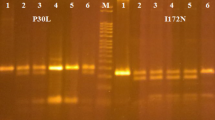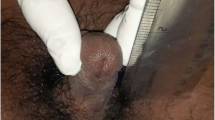Abstract
A 31-yr-old woman presenting with a history of hirsutism, amenorrhea, and infertility was previously assumed to have polycystic ovary syndrome. A new gynecological-endocrine evaluation demonstrated elevated testosterone/SHBG ratio, serum 17-hydrox-yprogesterone (17-OHP), and urinary pregnantriol. She was diagnosed with non-classic congenital adrenal hyperplasia. In spite of treatment with dexamethasone and fludrocortisone in doses that suppressed adrenal androgens and 17-OHP into normal range or below, she did not ovulate. Clomiphene citrate and then FSH/hCG treatment in several cycles gave no consistent ovulation. Progesterone levels remained elevated throughout the cycles indicating a possible contribution from the adrenals. Oral glucose tolerance was normal, but the homeostasis model assessment index indicated insulin resistance. With metformin 1500 mg daily the index decreased remarkably from 2.77 to 0.96 with a few ovulations but no pregnancy occurred. Three cycles of IVF treatment thereafter were unsuccessful. Three months after the last in vitro fertilization (IVF) cycle, still on dexamethasone, fludrocortisone, and metformin, her menstruations became regular and she thereafter became pregnant. During pregnancy metformin was discontinued and dexamethasone replaced with prednisolone. Mild gestational diabetes developed and insulin was given. A healthy boy was born at term by elective Cesarean section. A CYP21-gene analysis had not indicated any of the known mutations but after gene sequencing a novel mutation was found, namely R233G. This case confirms the necessity of adding an analysis of 17-OHP when evaluating women with hirsutism and menstrual disturbances and if an elevated value is found, the advantage of performing a mutation analysis to facilitate counseling and decisions on treatment.
Similar content being viewed by others
References
Speiser PW, Dupont B, Rubinstein P, Piazza A, Kastelan A, New MI. High frequency of nonclassical steroid 21-hydroxylase deficiency. Am J Hum Genet 1985, 37: 650–67.
Kuttenn F, Couillin P, Girard F, et al. Late-onset adrenal hyperplasia in hirsutism. N Engl J Med 1985, 313: 224–31.
Azziz R, Sanchez LA, Knochenhauer ES, et al. Androgen excess in women: experience with over 1000 consecutive patients. J Clin Endocrinol Metab 2004, 89: 453–62.
Falhammar H, Thorén M. An 88-year-old woman diagnosed with adrenal tumor and congenital adrenal hyperplasia: connection or coincidence? J Endocrinol Invest 2005, 28: 449–53.
White PC, Speiser PW. Congenital adrenal hyperplasia due to 21-Hydoxylase Deficiency. Endocr Rev 2000, 21: 245–91.
Moran C, Azziz R, Carmina E, et al. 21-Hydroxylase-deficient nonclassical adrenal hyperplasia is a progressive disorder: a multicenter study. Am J Obstet Gynecol 2000, 183: 1468–74.
Bonora E, Kiechl S, Willeit J, et al. Prevalence of insulin resistance in metabolic disorders: the Bruneck Study. Diabetes 1998, 47: 1643–9.
Robins T, Carlsson J, Sunnerhagen M, Wedell A, Persson B. Molecular model of human CYP21 based on mammalian CYP2C5: structural features correlate with clinical severity of mutations causing congenital adrenal hyperplasia. Mol Endocrinol 2006, 20: 2946–64.
Wedell A, Luthman H. Steroid 21-hydroxylase deficiency: two additional mutations in salt-wasting disease and rapid screening of disease-causing mutation. Hum Mol Genet 1993, 2: 499–504.
Axelson M, Sahlberg BL, Sjövall J. Analysis of profiles of conjugated steroids in urine by ion-exchange separation and gas chromatography-mass spectrometry. J Chromatogr 1981, 224: 355–70.
Matthews DR, Hosker JP, Rudenski AS, Naylor BA, Treacher DF, Turner RC. Homeostatis model assessment: insulin resistance and beta-cell function from fasting plasma glucose and insulin concentrations in man. Diabetologia 1985, 28: 412–9.
Zawadski JK, Dunaif A. Diagnostic criteria for polycystic ovary syndrome; towards a rational approach. In: Dunaif A, Givena JR, Haseltine F. eds. Polycystic ovary syndrome. Boston: Blackwell Scientific 1992, 377–84.
Rotterdam ESHRE/ASRM-Sponsored PCOS Consensus Workshop Group. Revised 2003 consensus on diagnostic criteria and long term health risks related to polycystic ovary syndrome. Fertil Steril 2004, 81: 19–25.
Azziz R, Carmina E, Dewailly D, et al. Position statement: criteria for defining polycystic ovary syndrome: an androgen excess society guideline. J Clin Endocrinol Metab 2006, 91: 4237–45.
Lobo RA, Goebelsmann U. Adult manifestation of congenital adrenal hyperplasia due to incomplete 21-hydoxylase deficiency mimicking polycystic ovarian disease. Am J Obstet Gynecol 1980, 138: 720–6.
New MI. Nonclassical congenital adrenal hyperplasia and the polycystic ovarian syndrome. Ann N Y Acad Sci 1993, 687: 193–205.
Kamel N, Tonyukuk V, Emral R, Corapcioglu D, Bastemir M, Güllü S. The prevalence of late onset congenital adrenal hyperplasia in hirsute women from central Anatolia. Endocrin J 2003, 50: 815–23.
Benjamin F, Deutsch S, Saperstein H, Seltzer VL. Prevalence of and markers for attenuated form of congenital adrenal hyperplasia and hyperprolactinemia masquerading as polycystic ovarian disease. Fertil Steril 1986, 46: 215–21.
Cobin RH, Futterweit W, Fiedler RP, Thornton JC. Adrenocorticotropic hormone testing in idiopathic hirsutism and polycystic ovarian disease: a test of limited usefulness. Fertil Steril 1985, 44: 224–6.
Bachega T, Billerbeck A, Marcondes J, Madureira G, Arnold I, Mendonca B. Influence of different genotypes on 17-hydoxyprogesterone levels in patients with nonclassical congenital adrenal hyperplasia due to 21-hydroxylase deficiency. Clin Endocrinol (Oxf) 2000, 52: 601–7.
Speiser PW, Serrat J, New MI, Gerner JM. Insulin insensitivity in adrenal hyperplasia due to nonclassical steroid 21-hydroxylase deficiency. J Clin Endocrinol Metab 1992, 75: 1421–4.
Saygili F, Oge A, Yilmaz C. Hyperinsulinemia and insulin insensitivity in women with nonclassical congenital adrenal hyperplasia due to 21-hydroxylase deficiency: the relationship between serum leptin levels and chronic hyperinsulinemia. Horm Res 2005, 63: 270–4.
Dunaif A. Insulin resistance and polycystic ovary syndrome: mechanism and implications for pathogenesis. Endocr Rev 1997, 18: 774–800.
Livingstone C, Collison M. Sex steroids and insulin resistence. Clin Sci (Lond) 2002, 102: 151–66.
Siebert TI, Kruger TF, Steyn DW, Nosarka S. Is the addition of metformin efficacious in the treatment of clomiphene citrate-resistant patients with polycystic ovary syndrome? A structured literature review. Fertil Steril 2006, 86: 1432–7.
Feldman S, Billaud L, Thalabard JC, et al. Fertility in women with late-onset adrenal hyperplasia due to 21-hydroxylase deficiency. J Clin Endocrinol Metab 1992, 74: 635–9.
Helleday J, Siwers B, Ritzén EM, Carlström K. Subnormal androgens and elevated progesterone levels in women treated for congenital virilizing 21-hydroxylase deficiency. J Clin Endocrinol Metab 1993, 76: 933–6.
Wedell A, Thilén A, Ritzén EM, Stengler B, Luthman H. Mutational spectrum of the steroid 21-hydroxylase gene in Sweden: implications for genetic diagnosis and association with disease manifestation. J Clin Endocrinol Metab 1994, 78: 1145–52.
Jääskeläinen J, Levo A, Voutilainen R, Partanen J. Population-wide evaluation of disease manifestation in relation to molecular genotype in steroid 21-hydroxylase (CYP21) deficiency: good correlation in a well defined population. J Clin Endocrinol Metab 1997, 82: 3293–7.
Speiser PW, New MI, White PC. Molecular genetic analysis of nonclassical 21-hydoxylase deficiency associated with HLA-B14,DR1. N Engl J Med 1988, 319: 19–23.
Owerbach D, Sherman L, Ballard AL, Azziz R. Pro-453 to Ser mutation in CYP21 is associated with nonclassic steroid 21-hydroxylase deficiency. Mol Endocrinol 1992, 6: 1211–5.
Wedell A, Ritzén ME, Haglund-Stengler B, Luthman H. Steroid 21-hydroxylase deficiency: three mutated alleles and establishment of phenotype-genotype relationships of common mutations. Proc Natl Acad Sci U S A 1992, 89: 7232–6.
Tunsie-Luna MT, Speiser PW, Dumic M, New MI, White PC. A mutation (Pro-30 to Leu) in CYP21 represents a potential nonclassic steroid 21-hydroxylase deficiency allele. Mol Endocrinol 1991, 5: 685–92.
Nikoshkov A, Lajic S, Holst M, Wedell A, Luthman H. Synergistic effect of partially inactivated mutations in steroid 21-hydroxylase deficiency. J Clin Endocrinol Metab 1997, 82: 194–9.
Helmberg A, Tusie-Luna MT, Tabarelli M, Kofler R, White PC. R339H and P453S: CYP21 mutations associated with nonclassic steroid 21-hydoxylase deficiency that are not apparent gene conversion. Mol Endocrinol 1992, 6: 1318–22.
Lajic S, Clauin S, Robins T, et al. Novel mutations in CYP21 detected in individuals with hyperandrogenism. J Clin Endocrinol Metab 2002, 87: 2824–9.
Moran C, Azziz R, Weintrob N, et al. Reproductive outcome of women with 21-hydroxylase-deficient nonclassic adrenal hyperplasia. J Clin Endocrinol Metab 2006, 91: 3451–6.
Author information
Authors and Affiliations
Corresponding author
Rights and permissions
About this article
Cite this article
Falhammar, H., Thorén, M. & Hagenfeldt, K. A 31-year-old woman with infertility and polycystic ovaries diagnosed with non-classic congenital adrenal hyperplasia due to a novel CYP21 mutation. J Endocrinol Invest 31, 176–180 (2008). https://doi.org/10.1007/BF03345586
Accepted:
Published:
Issue Date:
DOI: https://doi.org/10.1007/BF03345586




